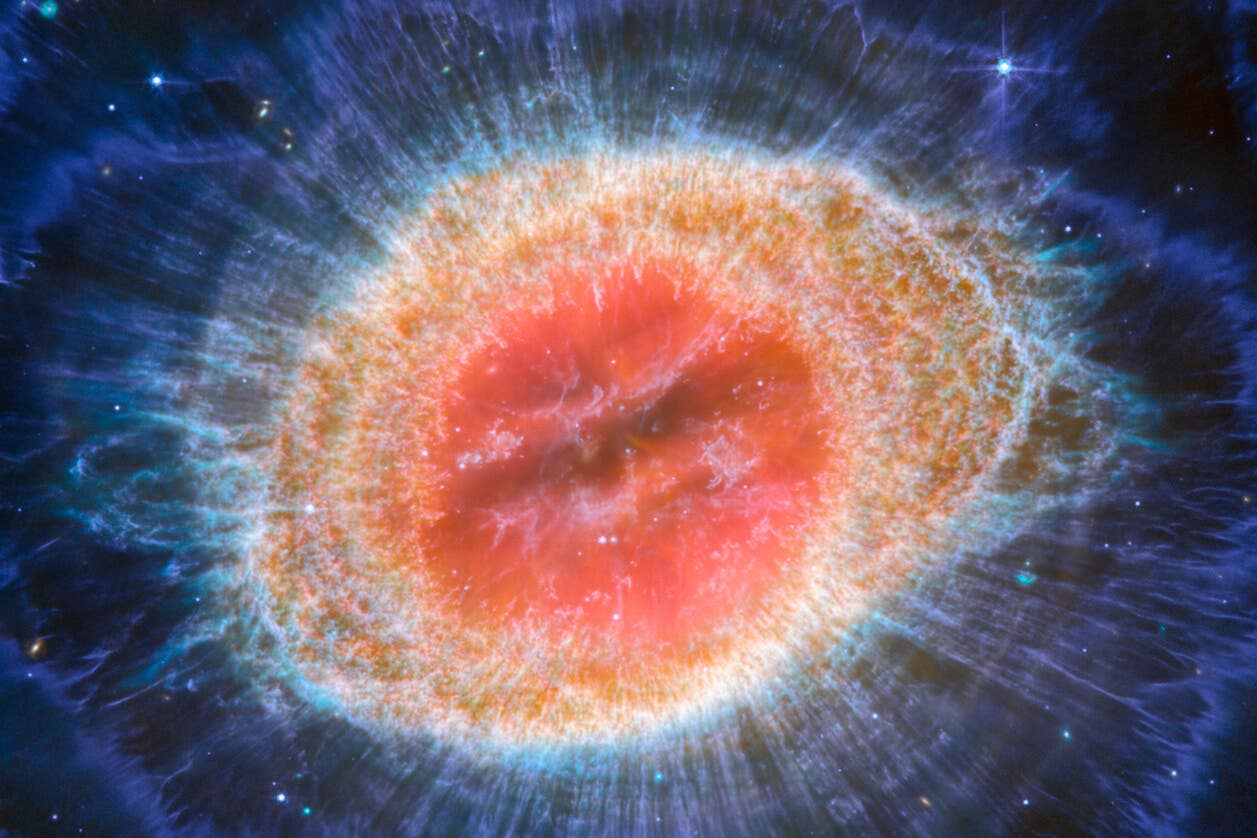New image of Ring Nebula reveals what sun might look like as it dies
The image was taken by the James Webb Space Telescope.

Astronomers have released a new image of the Ring Nebula revealing features in the outer regions of the ring.
The new observations provide a glimpse of what the sun might look like at the end of its life.
Formed by a star throwing off its outer layers as it runs out of fuel, the Ring Nebula is an archetypal planetary nebula – formed by an expanding shell of gas round an ageing star.
The image, from the James Webb Telescope’s Mid-Infrared Instrument (MIRI), follows an image issued earlier this month, showing the Ring Nebula at shorter wavelengths of infrared light.
This striking image from James Webb’s MIRI reveals new details that we could not observe with the NIRCam – notably the arcs beyond the main ring
The object, which is located about 2,600 light years away in the constellation Lyra, formed when a dying star ejected its outer layers about 4,000 years ago – the same fate eventually awaits our sun.
Researchers explain that the two images show its intricate structures – its rings, bubbles and wispy clouds – in exquisite, unprecedented detail.
The colours in the two images represent infrared (invisible) light of different wavelengths emitted by the chemical elements in the nebula and by warm dust particles.
The Ring Nebula is one of the most notable objects in our skies.
It was discovered in 1779 by astronomers Charles Messier and Antoine Darquier de Pellepoix.
Both astronomers stumbled upon the nebula when trying to follow the path of a comet through the constellation of Lyra.
Professor Mike Barlow, UCL Physics and Astronomy, lead scientist of the JWST Ring Nebula Project, said: “This striking image from James Webb’s MIRI reveals new details that we could not observe with the NIRCam – notably the arcs beyond the main ring.
“These formed in the central star’s red giant phase, before it threw off most of its material to become the current hot white dwarf star.
“Early analysis by our team suggests a low-mass companion star with an eccentric orbit triggered an enhanced release of material from the dying star as it passed close by every 280 years, creating these arcs.”
The main ring of the nebula is made up of 20,000 clumps of dense molecular hydrogen gas, each about the mass of the Earth.
The inner region is mainly made up of this hot gas. The main shell also contains a thin ring of enhanced emission from carbon-based molecules known as polycyclic aromatic hydrocarbons (PAHs).
Experts say the new image reveals, for the first time, 10 or so concentric arcs located just beyond the outer edge of the main ring.
According to the astronomers, these arcs must have formed about every 280 years.
Because no known process involved in the evolution of a star into a nebula has that kind of time period, it is believed the arcs formed from the interaction of the dying red giant star with a companion star located the same distance away from it as Pluto is from the sun.
Dr Roger Wesson, of Cardiff University, said: “Our MIRI images provided us with the sharpest and clearest view yet of the faint molecular halo outside the bright ring.
“A surprising revelation was the presence of up to 10 regularly spaced, concentric features within this faint halo.
“No previous telescope had the sensitivity and the spatial resolution to uncover this subtle effect.”
The international research team analysing these images involves researchers from the UK, France, Canada, USA, Sweden, Spain, Brazil, Ireland and Belgium.
The James Webb Space Telescope is an international partnership between NASA, ESA and the Canadian Space Agency (CSA).
Bookmark popover
Removed from bookmarks